
Scientists are studying the role that birds play in turbulence prediction, which is crucial for meteorological and aviation research.
This research could lead to improved predictions and strategies for managing turbulence, which is an issue that is growing more and more problematic for the airline industry.
Birds Movement
These days, meteorologists are working to improve computer modeling techniques for predicting all kinds of turbulence. But until recently, one untapped source of data was the birds with whom we share the skies.
Earlier study suggest that animal motions can provide information about wind direction, speed, and strength during thermal updrafts.
According to Swansea University experts, birds' perception of the wind may be useful in forecasting turbulence. Birds frequently migrate over thousands of kilometers, and the amount of energy they must consume while traveling depends on wind direction, speed, and turbulence.
Catching the wrong winds can also be the difference between life and death when you're running low on supplies at the end of a life-changing journey halfway around the globe.
Some species reach very high altitudes, although most don't fly alongside cruising commercial jets.
Consider frigate birds as an example. Shepard describes their flight as a "roller-coaster". They can fly at extremely high heights of up to 13,000 feet (4 km/2.5 miles) above the earth, but they depend on thermals and wind to stay up there for months at a time. They frequently catch strong updrafts in mountainous cumulus clouds to reach this incredible height.
Emily Shepard, an expert in bird flight and air flow and her colleagues at Swansea University's Laboratory for Animal Movement hope to "visualize the invisible" and chart the movements of the air by examining how these birds react to turbulence.
Shepard's team flew an ultralight aircraft alongside a flock of homing pigeons from 2018 to 2019. They recorded the turbulence levels during the birds' flights back to their lofts using GPS, barometric pressure, and acceleration data recorders mounted to the birds-a total of 88 flights.
The team flew in a range of weather situations, including early mornings when there wasn't much heat from the earth to create choppy convective currents, later in the day when thermals were greater, and several seasons.
Read Also : Singapore Airlines Flight: Experts Say Deaths Are Rare Even As Climate Change May Cause Extreme Turbulence
Bird-borne Sensors
Experts said birds might serve as mobile meteorological sensors, gathering information about any disturbance they encounter as they soar. Not only can birds fly in conditions that planes cannot, Shepard continues, but this would also be less expensive than employing sensors installed on aircraft.
Similar to seal-borne sensors used to detect salinity and water temperature, Swansea University research reveals the possibility of utilizing bird-borne sensors to shed light on air turbulence.
"People are already equipping animals with tags for lots of different reasons and in lots of different environments. They're effectively sampling in the environment all the time," Shepard added.
This knowledge is critical to the airline business and weather science at large because it enables meteorologists and pilots to anticipate and manage turbulence more effectively.
While certain potential exist for modern aircraft technologies to detect and avoid turbulence, research on animal behavior in the air may offer a fresh and more sophisticated method of comprehending this phenomenon.
Related Article : Climate Change Could Mean More Turbulence: A Study
© 2025 NatureWorldNews.com All rights reserved. Do not reproduce without permission.





